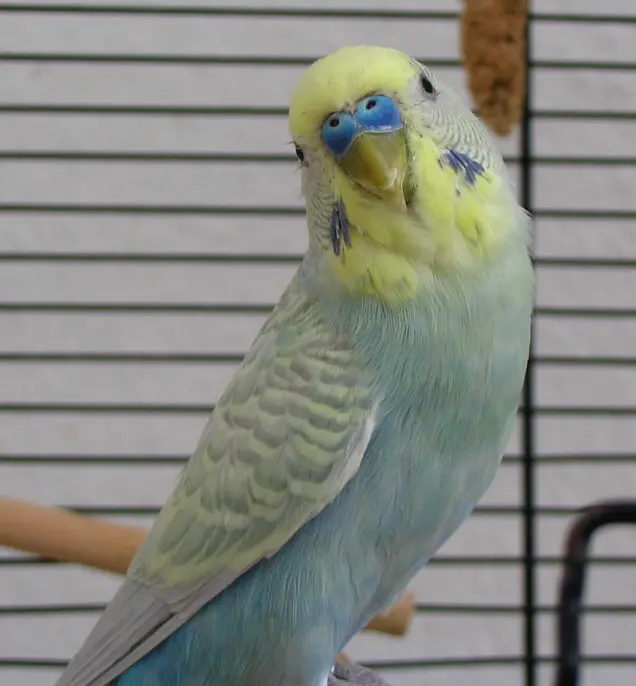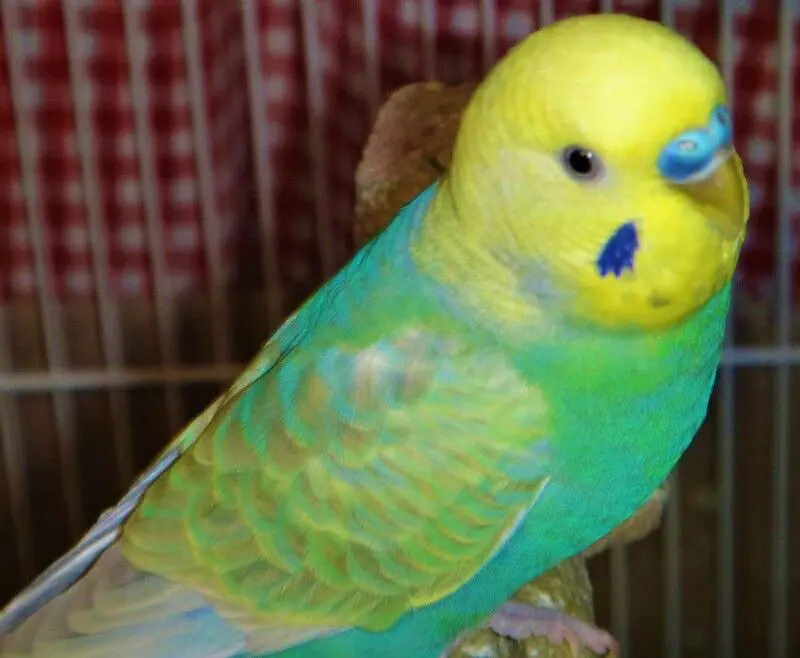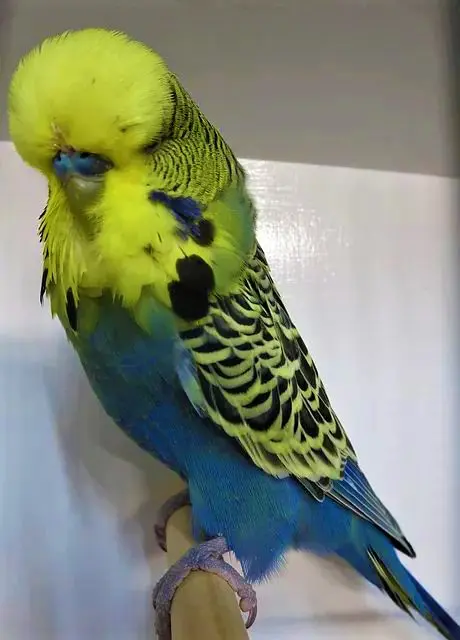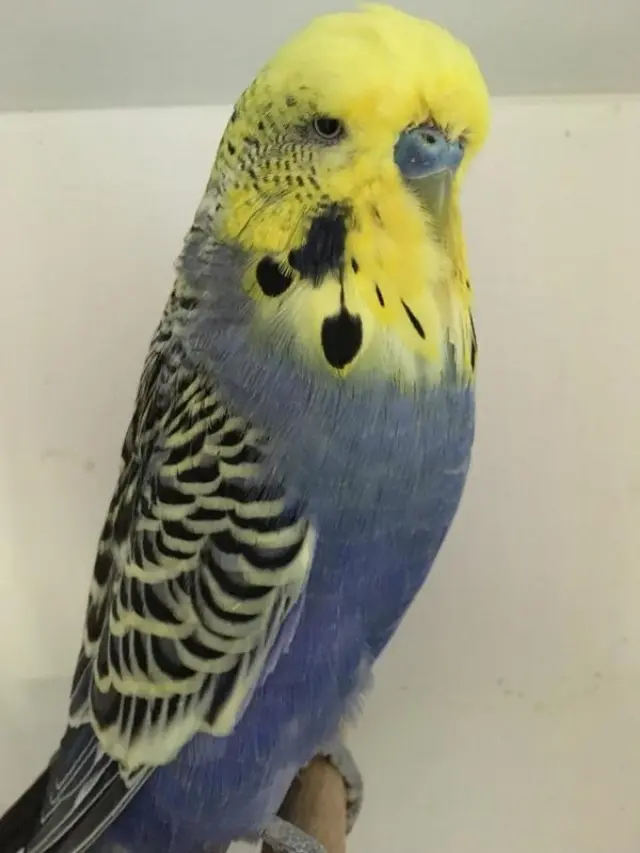The transition of a budgie’s color to yellow can be instigated by genetic mutations, specifically the yellow face mutation.
On the other hand, moulting, changes in diet, illnesses, or even external factors in the budgie’s environment can influence the color transformation.
As someone who has a passion for birds, particularly budgies, I’ve frequently come across queries about these adorable avians.
A question that rarely arises is, “Why is my budgie turning yellow?”.
Don’t worry, I am here to provide you a detailed guide on why this might be happening.
Both genetic and non-genetic factors could be the culprits behind your budgie’s transformation.
Genetic Factors
Genetics play a key role in the coloration of budgies.
There are specific mutations that can cause a budgie’s feathers to appear yellow.
Let’s have a look at some of these.
Yellow Face Mutations
The color of a budgie’s face could change due to genetic factors, specifically due to yellow face mutations.
These mutations can be complex to understand, but basically, they cause a budgie to have a yellowish face.
There are several types of these mutations.
Yellow Face Type 1, Single Factor
The Yellow Face Type 1, Single Factor mutation in budgies is an intriguing genetic occurrence that alters the color scheme of these charming birds.
A budgie with this mutation is primarily characterized by a light or pale yellow coloration on its face.

This intriguing change is specific to the head region and does not extend to the body of the bird, which maintains its original hue, typically a shade of white, blue, or grey.
Understand that the color transformation due to this mutation is subtle.
For instance, consider a budgie with a sky blue body color and a white head, which is a common color combination.
If this bird has the Yellow Face Type 1, Single Factor mutation, its head will transform from white to a light yellow hue.
Meanwhile, its body remains the familiar sky blue.
This mutation’s impact on the budgie’s appearance is essentially a delicate layer of yellow coloration on the face, which overlays the existing color without modifying or influencing the body color.
Yellow Face Type 2, Single Factor
The Yellow Face Type 2, Single Factor mutation in budgies presents a distinctive appearance, differentiating these birds from their counterparts.
Primarily, a budgie carrying this mutation displays a bright, deep yellow face, contrasting the Yellow Face Type 1 mutation, which gives a light or pale yellow face.

In this mutation, the vibrant yellow hue is not just confined to the face.
Upon the bird’s first moult, the yellow pigment starts to spread into the body feathers.
The result is a body color that looks like a fusion of the bird’s original color and the intense yellow hue.
For instance, a budgie that has a sky blue body and a bright yellow face will, after moulting, display a greenish body color.
This green color results from the yellow pigment overlaying the original sky blue body color.
Golden Face, Single Factor
The Golden Face, Single Factor is another notable mutation that impacts the coloration of budgies, specifically creating a striking gold coloration on the face.
As the name suggests, a budgie carrying this mutation will display a vibrant golden-yellow facial hue, quite different from the light yellow or bright yellow seen in the Yellow Face Type 1 and Type 2 mutations.
Golden Face budgies start showing their distinctive coloration after their first moult, much like Yellow Face Type 2 budgies.
The golden-yellow pigment of the face starts to infuse into the body feathers.

This results in the budgie’s body color taking on a beautiful golden tinge overlaying its original body color.
Let’s take an example of a budgie with a blue body and a golden face.
After the first moult, this budgie’s body color will become a turquoise-like shade, a blend of the original blue body color and the golden-yellow hue from the face.
The result is a truly beautiful, unique color combination that differentiates these budgies from others.
Golden Face, Double Factor
The Golden Face, Double Factor mutation represents an even more pronounced version of the Golden Face mutation in budgies.
Budgies carrying two copies of this gene (hence, “double factor”) display a much more intense golden-yellow facial coloration compared to their single factor counterparts.
In this mutation, the budgie’s face is a rich, deep golden color, which extends beyond the face and permeates all the body feathers as well.

After the budgie undergoes its first moult, this deep golden color fully saturates the bird’s body, transforming the base color into a rich, deep golden tone, much more vibrant than that seen in single factor golden face budgies.
Let’s take the example of a blue-bodied budgie with the Golden Face, Double Factor mutation.
After its first moult, this budgie’s body would not just have a golden tinge overlaying its blue feathers, but it would transform into a deep turquoise shade, the result of a more pronounced infusion of the golden hue.
Non-Genetic Factors
While genetics play a major role in your budgie’s color, non-genetic factors can also cause color changes.
Let’s consider a few such factors.
Moulting
Moulting is a completely natural process that all birds undergo, and budgies are no exception.
Essentially, moulting is when birds shed their old feathers to make way for new ones.
The process of moulting allows budgies to maintain the health and functionality of their plumage, which is crucial for flight and thermoregulation.
Typically, a budgie will experience its first moult around 3 to 4 months of age.
This moult is significant as it helps the budgie transition from its juvenile plumage to adult plumage.
During this time, you may notice a significant amount of feathers around your budgie’s cage.
This is perfectly normal, as budgies lose feathers from all parts of their body, including the wings, tail, and body.
Moreover, the effects of some budgie color mutations, such as Yellow Face and Golden Face, become more apparent after the bird’s first moult.
In these cases, the bird’s true colors emerge and become fully saturated after the old feathers have been replaced.
Moulting is a recurring process, with budgies typically moulting once or twice a year after their first moult.
It’s a key aspect of a budgie’s life cycle, reflecting its overall health and also playing a role in the expression of certain color mutations.
Illness
Health issues, such as liver disease, can also impact your budgie’s feather color.
Diet, Malnutrition
The diet of your budgie can also contribute to color changes.
A lack of essential nutrients might lead to color changes in your budgie’s feathers.
Stress Or Other Behavioral Changes
Just like humans, budgies can also exhibit physical changes due to stress or behavioral changes.
This could potentially include changes in feather color.
It’s important to keep an eye on your budgie’s behavior.
External, Environmental Factors
Sometimes, your budgie might come into contact with substances or objects that could temporarily stain their feathers yellow.
An example of this could be residue from a pineapple-flavored cuttlebone, which could make their feathers appear yellow.
Faqs
There are also several frequently asked questions on the subject of budgies changing color.
Let’s tackle a few of them.
When Do the Effects of Yellow Face And Golden Face Mutations Begin to Be Appeared?
The effects of the Yellow Face and Golden Face mutations in budgies typically start to become evident when the bird begins to molt and grow in its adult feathers, around 3 to 4 months of age.
During this period, you might notice the budgie’s head or entire body starting to take on a yellow tint, depending on the specific mutation.
These mutations affect the color of the feathers as they grow in, not the color of existing feathers.
Therefore, it’s only when the budgie begins to molt and grow in new feathers that the effects of these mutations become visible.
Keep in mind that a budgie’s coloration can change slightly with each molt throughout its life due to these genetic factors.
What’s the Difference Between Lutino Budgies and Budgies Whose Feathers Turn Yellow?
Lutino Budgies are the result of a specific genetic mutation that gives them their distinctive, all-yellow feathering.
This is a recessive trait, meaning both parents must carry the gene for the offspring to display the characteristic.
Unlike color changes caused by diet or environment, this yellow coloration is permanently encoded in their DNA and is present from birth.
On the other hand, when a budgie’s feathers are turning yellow, it’s often related to a Yellow Face or Golden Face genetic mutations.
These mutations can add yellow pigment to different parts of the budgie’s body, and the specific characteristics depend on whether it’s a Type 1 or Type 2 mutation, or a Golden Face mutation.
Each type of mutation has different rules of inheritance and can be combined with other mutations.
However, the yellow coloration seen with these mutations is usually not as uniform or intense as the color of a Lutino budgie.
Do Budgies Change Colour When They Get Older?
Yes, budgies can undergo color changes as they age.
These changes are usually associated with their moulting cycles, and it’s completely normal.
How Can I Determine if My Budgie’s Yellow Color is Genetic or Not?
Determining if a budgie’s yellow coloring is due to genetic factors can be challenging.
Typically, genetic changes are consistent and permanent, while color shifts due to environmental influences or health issues may be temporary.
If the yellow color is concentrated on the face and/or body, and is consistent with the descriptions of Yellow Face or Golden Face mutations, it may be genetic.
If you’re uncertain, it’s best to consult with a veterinary expert who has experience with budgies.
Can a Budgie’s Diet Influence Its Feather Color?
Absolutely, a budgie’s diet can have a significant impact on its feather color.
If a budgie is not getting a balanced diet with the necessary vitamins and minerals, its feather color may change.
For example, a deficiency in certain vitamins or minerals could lead to a yellowish tinge in the feathers.
Conversely, certain foods or supplements with strong pigments might also temporarily color a budgie’s feathers.
What Should I Do if My Budgie’s Feathers Are Turning Yellow?
If your budgie’s feathers are turning yellow, the first step is to observe its overall behavior and health.
Are there any changes in eating habits, activity levels, or behavior? If there are noticeable changes, or if the yellow color persists, it’s a good idea to consult an avian veterinarian.
They can help determine if the color change is due to a health issue, environmental factors, or a genetic mutation.
How Can Environmental Factors Contribute to a Budgie Turning Yellow?
Environmental factors can sometimes result in a budgie’s feathers turning yellow.
These might include the budgie coming into contact with objects or substances that have a strong yellow pigment, such as certain types of cuttlebone or mineral blocks.
Additionally, exposure to smoke or certain chemicals might discolor a budgie’s feathers.
It’s important to ensure that your budgie’s environment is clean and free of any potential hazards.
![Why is my budgie’s cere turning brown? [MALE & FEMALE]](https://www.petiska.com/wp-content/uploads/2022/03/why-is-my-budgies-cere-turning-brown-male-female-1646851856-400x300.jpg)
![Top 130+ Best Yellow Budgie Names [Females, Males, Unisex]](https://www.petiska.com/wp-content/uploads/2022/04/top-130-best-yellow-budgie-names-females-males-unisex-1651078822-400x300.jpg)

